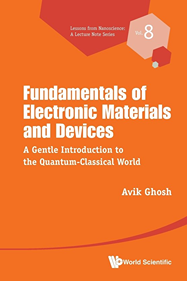Fundamentals of Electronic Materials and Devices a Gentle Introduction to the Quantum Classical World
Material type: TextLanguage: English Series: Lessons from Nano Science a Lecture Note Series ; Vol. 8Publication details: New Jersey : World Scientific, c2023Description: xv, 331 p. : illISBN:
TextLanguage: English Series: Lessons from Nano Science a Lecture Note Series ; Vol. 8Publication details: New Jersey : World Scientific, c2023Description: xv, 331 p. : illISBN: - 9789811266577
- 621.381 GHO
| Item type | Current library | Collection | Shelving location | Call number | Copy number | Status | Date due | Barcode |
|---|---|---|---|---|---|---|---|---|
 Lending Collection
Lending Collection
|
Circulation Section | Department of Electronic Engineering | Circulation Section | 621.381 GHO | 2023-2024 | Available | 98504 |
AUTHOR
Avik Ghosh is Professor at the Charles Brown Department of Electrical and Computing Engineering and the Department of Physics at the University of Virginia. He holds a PhD in theoretical condensed matter physics from the Ohio State University and a postdoctoral fellowship in Electrical Engineering from Purdue University. He is also the UVA site-director of the NSF-Industry University Cooperative Center on Multifunctional Integrated Systems Technology (MIST). Ghosh has authored 150+ refereed papers and a book (Nanoelectronics — A Molecular View, World Scientific 2016) in the area of computational nanomaterials and device physics. He has given over 150 invited lectures worldwide. He is Fellow of the Institute of Physics (IOP), senior member of the IEEE, and has received the IBM Faculty Award, the NSF CAREER Award, a best paper award from the Army Research Office, and UVA's All University Teaching Award. His group's work with Columbia University on demonstrating negative index behavior in graphene was voted by the editors of Physics World as one of the top 10 research breakthroughs of 2016.
SUMMARY
The Romans built enduring bridges well before Newton came along, armed simply with a working knowledge of mechanics and materials. In contrast, today's bridge building is an elaborate enterprise involving CAD tools, composite materials and acoustic imaging. When technology is pushed to its limits, a working knowledge proves inadequate, and an in-depth understanding of core physical principles, both macroscopic and microscopic, top-down vs bottom-up, becomes essential.
We find ourselves today at a similar crossroad in semiconductor device technology, where a working knowledge of solid state electronics is no longer enough. Faced with the prohibitive cost of computing and the slowdown of chip manufacturing, device scaling and the global supply chain, the semiconductor industry is forced to explore alternate platforms such as 2-D materials, spintronics, analog processing and quantum engineering.
This book combines top-down classical device physics with bottom-up quantum transport in a single venue to provide the basis for such a scientific exploration. It is essential, easy reading for beginning undergraduate and practicing graduate students, physicists unfamiliar with device engineering and engineers untrained in quantum physics. With just a modest pre-requisite of freshman maths, the book works quickly through key concepts in quantum physics, Matlab exercises and original homeworks, to cover a wide range of topics from chemical bonding to Hofstader butterflies, domain walls to Chern insulators, solar cells to photodiodes, FinFETs to Majorana fermions. For the practicing device engineer, it provides new concepts such as the quantum of resistance, while for the practicing quantum physicist, it provides new contexts such as the tunnel transistor.
